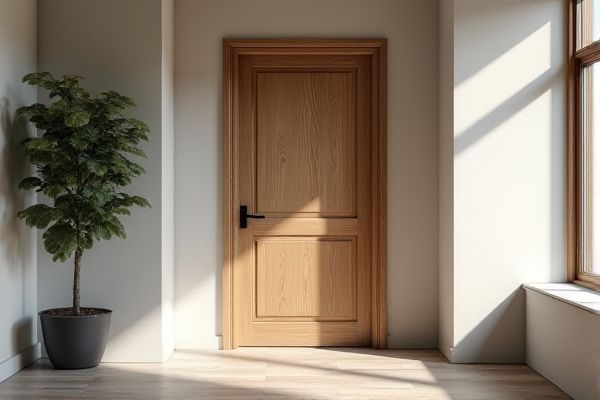
Slab doors feature a simple, flat surface providing a sleek, modern look, while raised panel doors have decorative, contoured panels offering a traditional and textured appearance. Discover which door style best suits Your home's design and functionality by reading the full article.
Table of Comparison
| Feature | Slab Door | Raised Panel Door |
|---|---|---|
| Design | Flat, smooth surface | Center panel raised above frame |
| Style | Modern, minimalist | Traditional, classic |
| Material | Solid wood, MDF, or laminate | Solid wood, often with detailed molding |
| Cost | Generally more affordable | Typically higher due to craftsmanship |
| Durability | Durable, less prone to warping | Durable but may need maintenance on raised edges |
| Installation | Simple and quick | More complex due to panel construction |
| Customization | Limited to surface finish and color | Wide range of styles and profiles |
Introduction to Slab and Raised Panel Doors
Slab doors feature a flat, smooth surface that offers a sleek, modern look and easy customization with paint or veneers. Raised panel doors showcase a center panel that is elevated above the surrounding frame, creating a classic, dimensional appearance often found in traditional or craftsman-style homes. You can choose between slab or raised panel doors based on your desired aesthetic and the architectural style of your space.
Key Differences Between Slab and Raised Panel Doors
Slab doors feature a flat, smooth surface with no decorative elements, offering a minimalist and modern look, while raised panel doors include a central panel that is elevated and framed, providing a classic and detailed appearance. Raised panel doors are often made from solid wood or engineered wood and showcase craftsmanship with intricate molding, whereas slab doors are typically simpler, made from materials like MDF, plywood, or solid wood for a sleek aesthetic. Functionally, raised panel doors can conceal wear and add texture to cabinetry and furniture, whereas slab doors emphasize clean lines and are easier to clean and maintain.
Aesthetic Appeal: Modern vs Traditional Styles
Slab doors showcase a sleek, minimalist aesthetic ideal for modern and contemporary interiors, offering clean lines and a smooth surface that complements streamlined decor. Raised panel doors feature intricate detailing and dimensional panels, evoking a classic, traditional style that adds depth and elegance to your space. Choosing between slab and raised panel doors depends on whether you want your home to reflect a modern simplicity or a timeless, ornate charm.
Material Options for Each Door Type
Slab doors are commonly crafted from solid wood, MDF, plywood, or laminate, offering versatile options for customization and cost efficiency. Raised panel doors typically use solid wood or engineered wood with intricate carvings, providing a more traditional and durable aesthetic. Your choice depends on desired style, budget, and maintenance preferences for each material option.
Durability and Maintenance Considerations
Slab doors offer superior durability due to their solid, flat construction, making them resistant to warping and easier to clean, which reduces maintenance efforts. Raised panel doors, with their intricate design and recessed edges, require more frequent upkeep to prevent dirt buildup and potential damage to the raised sections. Choosing slab doors for your space ensures a low-maintenance, long-lasting option that withstands daily wear and tear effectively.
Cost Comparison: Slab vs Raised Panel Doors
Slab doors typically cost less than raised panel doors due to simpler manufacturing processes and fewer materials involved. Raised panel doors require more intricate craftsmanship, which increases labor costs and overall price. Homeowners can expect raised panel doors to be 20-40% more expensive than slab doors, depending on wood type and finish.
Installation Process and Complexity
Slab doors feature a straightforward installation process due to their flat, solid construction, requiring minimal adjustments and simpler hardware alignment. Raised panel doors demand more precise fitting because of their intricate panel design, often necessitating careful hinge placement and potential trimming to ensure proper operation. The complexity of raised panel door installation generally requires more time and skill compared to the more user-friendly slab door setup.
Best Applications for Slab and Raised Panel Doors
Slab doors are best suited for modern and minimalist interiors due to their smooth, flat surface that complements sleek cabinetry and contemporary decor. Raised panel doors work well in traditional or classic settings where intricate detailing and depth add character to kitchen or bathroom cabinets. Both types of doors offer durable options, but slab doors excel in spaces requiring a clean, streamlined look, while raised panel doors enhance rooms with a more formal or ornate style.
Energy Efficiency and Insulation Factors
Slab doors typically offer better energy efficiency due to their solid, uniform construction, which minimizes air leaks and enhances insulation. Raised panel doors, while visually appealing with their intricate design, can have more seams and joints that potentially reduce their ability to insulate effectively. Choosing slab doors with high-quality materials and weatherstripping improves overall thermal performance, reducing heating and cooling costs.
Choosing the Right Door Style for Your Space
Slab doors offer a sleek, modern look with clean lines, making them ideal for minimalist or contemporary spaces, while raised panel doors provide classic depth and detail suited for traditional or formal interiors. Your choice should consider the overall aesthetic of your room, the level of maintenance you're willing to commit to, and how the door style complements existing architectural features. Selecting the right door style enhances your space's harmony and functionality, ensuring your design vision comes to life.
 homyna.com
homyna.com